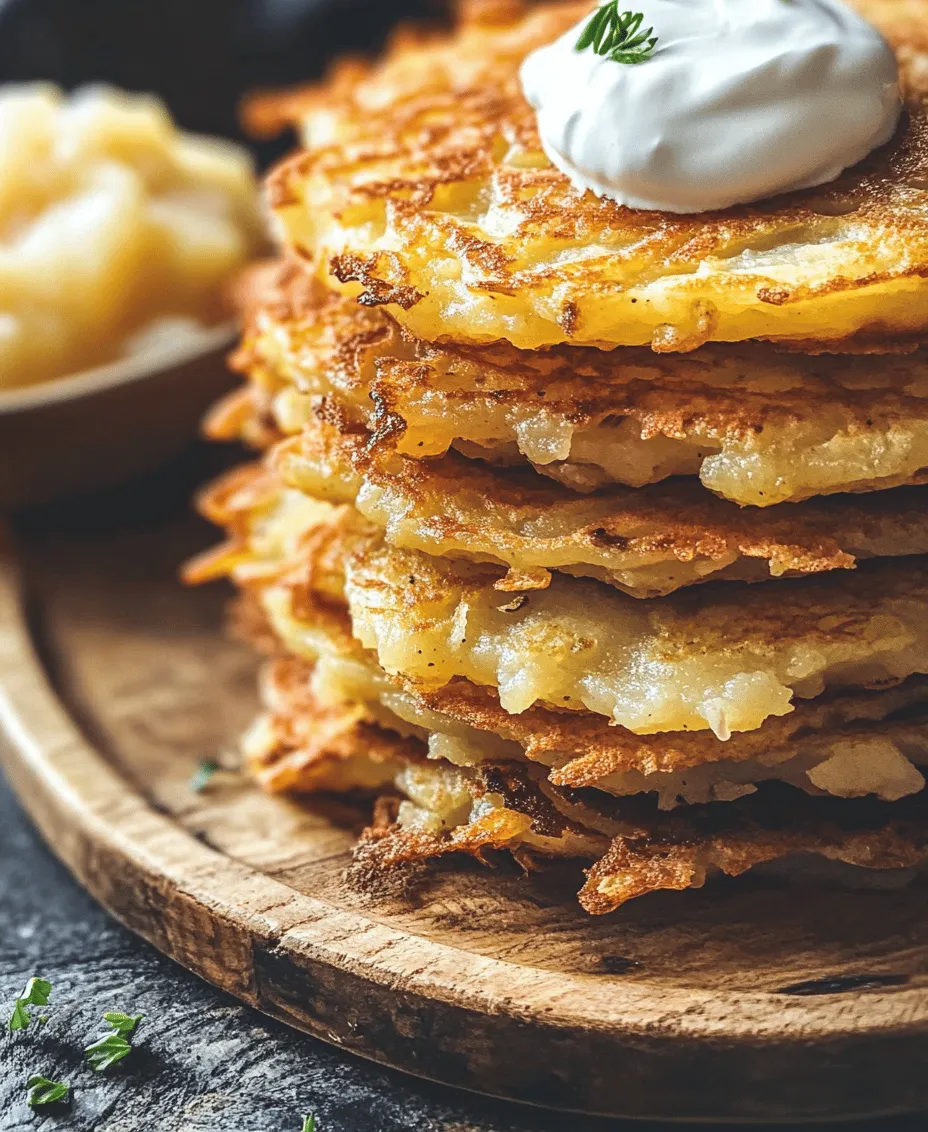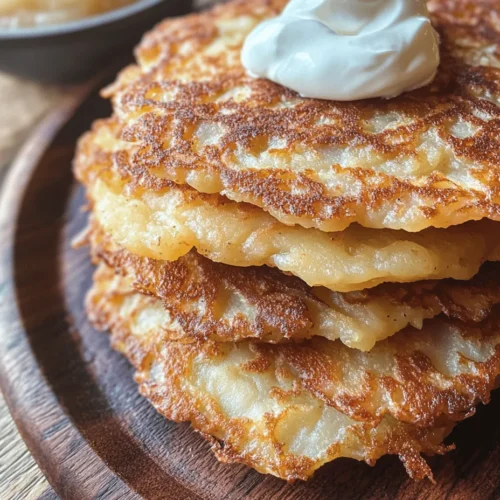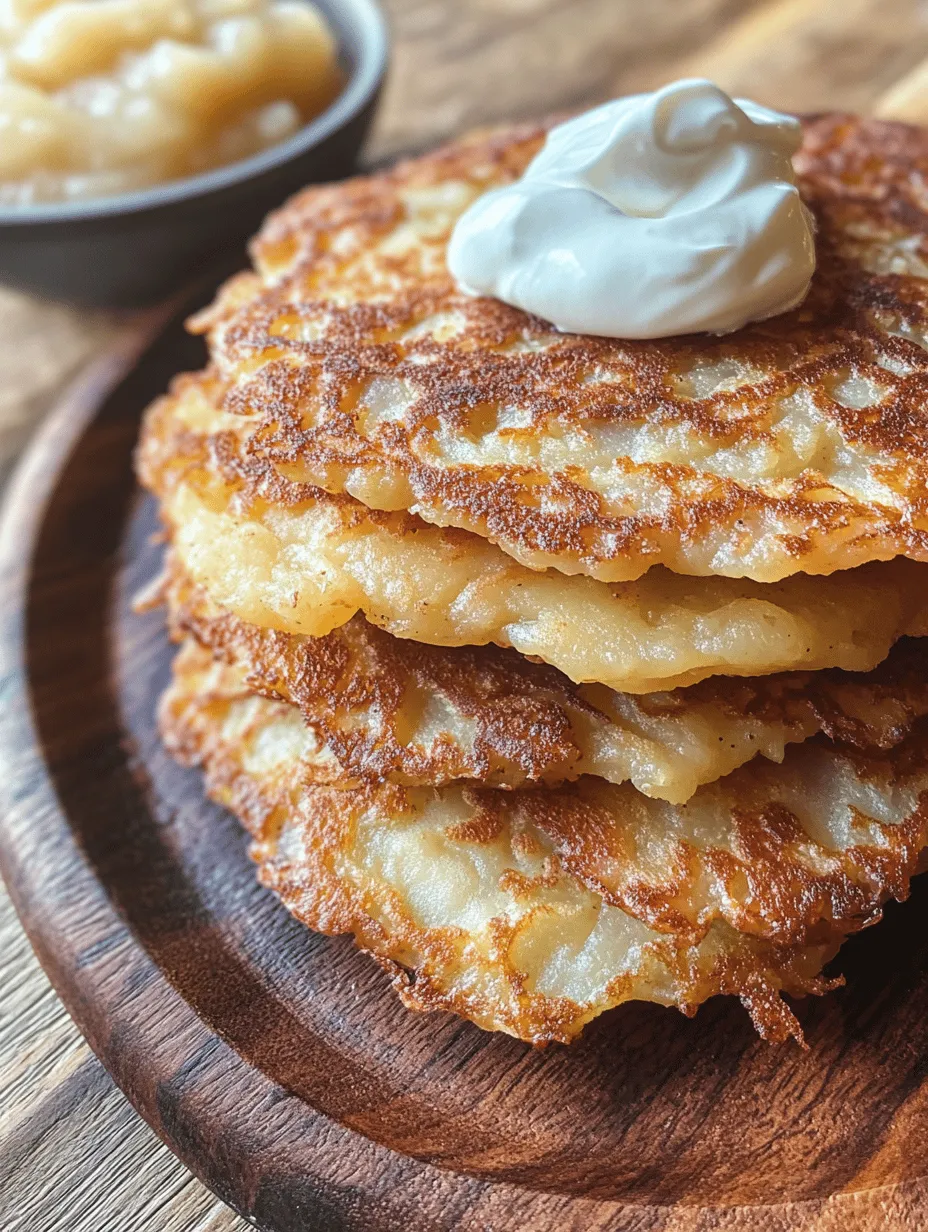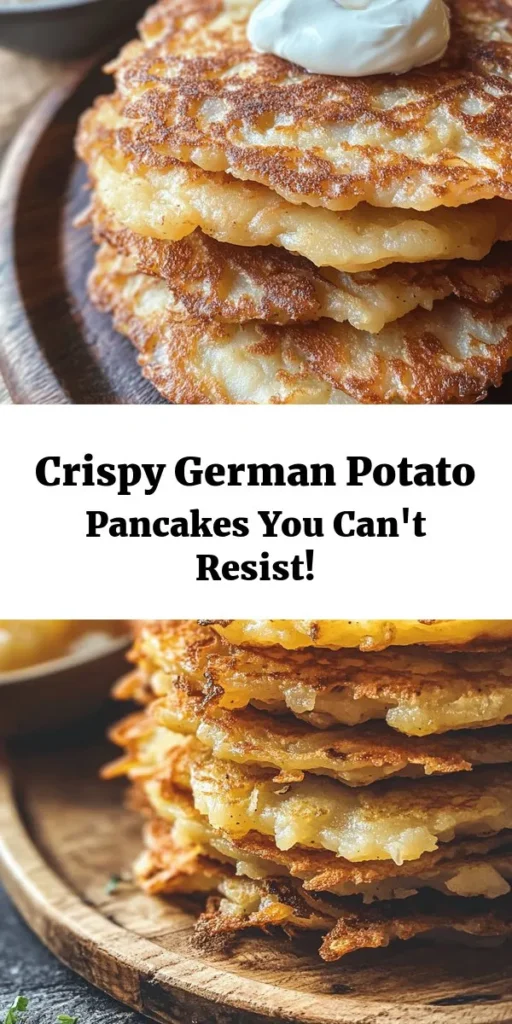Introduction
German cuisine is renowned for its hearty and comforting dishes, offering a delightful blend of flavors and textures that warm the soul. Among the many beloved staples of this rich culinary tradition, potato pancakes, known as “Reibekuchen” or “Kartoffelpuffer,” hold a special place in the hearts of many. These crispy, golden-brown delights are not only a popular street food but also a cherished dish served at family gatherings and festive occasions throughout Germany.
The allure of potato pancakes lies not only in their taste but also in the perfect balance of crispiness and softness. Achieving that coveted crunch on the outside while maintaining a tender interior is the hallmark of a truly authentic German potato pancake. Whether served with a dollop of applesauce or a side of sour cream, these pancakes are a versatile dish that can be enjoyed at any time of day, making them a staple in German households.
The Origins of Potato Pancakes
To fully appreciate the crispy potato pancake, it is essential to delve into its history. Potato pancakes have a storied past that dates back to the introduction of the potato to Europe from South America in the late 16th century. As the potato became a staple food across the continent, various cultures began to adapt it into their culinary traditions, including Germany.
In Germany, potato pancakes vary significantly from region to region. In the Rhineland, for example, they are often spiced with nutmeg and served with applesauce, while in Bavaria, they may be enjoyed with a side of sour cream and fresh herbs. Each region’s variation reflects local ingredients and cultural preferences, showcasing the adaptability of this simple yet delicious dish.
Culturally, potato pancakes are often associated with celebrations and communal gatherings. They are a popular dish during harvest festivals and Christmas markets, where vendors sell them hot off the griddle. The act of grating potatoes and frying them up can bring friends and family together, making it a communal activity that evokes warmth and nostalgia.
Ingredients Breakdown
To create the perfect crispy potato pancakes, selecting the right ingredients is crucial. Here’s a closer look at each component that contributes to the flavor and texture of this beloved dish.
Potatoes
The star ingredient of potato pancakes is, of course, the potatoes. For optimal results, russet potatoes are recommended due to their high starch content, which helps to achieve a crispy exterior while keeping the inside fluffy. The natural moisture in russets also aids in creating the right texture. When preparing the potatoes, it’s essential to choose ones that are firm and free of blemishes, as this will ensure a consistent quality in your pancakes.
Onions
Onions play a pivotal role in enhancing the flavor profile of potato pancakes. They add a subtle sweetness and depth that complements the earthiness of the potatoes. Finely grating or chopping the onions allows the flavors to meld seamlessly with the potato mixture. Some recipes may use shallots for a milder taste, but traditional German versions often stick to yellow or white onions.
Eggs
Eggs act as a binding agent in potato pancake recipes. They provide structure and help hold the ingredients together during frying. Additionally, eggs contribute moisture, preventing the pancakes from becoming too dry. When whisked into the potato mixture, eggs help to create a cohesive batter that maintains its shape when cooked.
Flour and Baking Powder
Incorporating flour into the potato mixture is essential for achieving the desired consistency. Flour helps absorb excess moisture from the potatoes, contributing to the overall crispiness of the pancakes. A small amount of baking powder can also be added to enhance the lightness of the pancakes, giving them a slightly airy texture that contrasts beautifully with the crispy exterior.
Frying Oil
The choice of frying oil significantly impacts the flavor and texture of potato pancakes. Traditionally, lard or clarified butter is used for frying, imparting a rich taste. However, vegetable oils such as canola or sunflower oil are excellent alternatives for those seeking a lighter option. Regardless of which oil you choose, ensure it has a high smoke point to achieve the ideal frying temperature without compromising the pancakes’ crispiness.
Optional Serving Suggestions
Potato pancakes can be enjoyed plain or dressed up with various accompaniments. The classic pairing is applesauce—a sweet and tangy contrast that balances the savory flavor of the pancakes. Alternatively, sour cream adds a creamy, tangy element that enhances the overall experience. Each serving suggestion offers a unique take on this traditional dish, allowing you to customize it to your taste preferences.
Preparation Steps for Perfect Potato Pancakes
Now that you understand the importance of each ingredient, let’s dive into the preparation steps to ensure your potato pancakes turn out crispy and delicious.
Step 1: Preparing the Potatoes
Begin by peeling and thoroughly rinsing the russet potatoes to remove any dirt. Once cleaned, the next crucial step is to grate the potatoes. Using a box grater or a food processor with a grating attachment, shred the potatoes into fine pieces. The finer the grating, the more evenly the pancakes will cook, and the crispier they will become.
Step 2: Removing Excess Moisture
One of the secrets to achieving the perfect crispy texture is removing excess moisture from the grated potatoes. After grating, place the potato shreds in a clean kitchen towel or cheesecloth, and twist the fabric to squeeze out as much liquid as possible. This step is vital; too much moisture will result in soggy pancakes that lack the desired crunch.
Step 3: Combining Ingredients
In a large mixing bowl, combine the squeezed potato shreds with finely grated onions, eggs, flour, and a pinch of baking powder. Mix everything thoroughly to create a cohesive batter. The consistency should be sticky enough to hold together when formed into patties but not too wet. If the mixture feels too loose, you can add a little more flour to achieve the right balance.
Step 4: Achieving the Ideal Texture
For the potato pancake mixture to hold together during frying, it is essential to create a sticky texture. This can be accomplished by ensuring that the potatoes and onions are evenly distributed throughout the batter and that the eggs are well incorporated. You can test the mixture by forming a small patty in your hands; if it holds its shape without crumbling, you are ready to fry.
With the preparation steps in place, you are well on your way to creating authentic German potato pancakes that are crispy on the outside and tender on the inside. In the following sections, we will discuss frying techniques, tips for serving, and how to elevate this classic dish to new heights. Stay tuned for more culinary insights that will guide you through the process of making these delectable treats!

Frying Techniques for Crispiness
To achieve the perfect crispy texture that authentic German potato pancakes are known for, mastering the frying technique is essential. Here’s a detailed guide on how to fry these delicious pancakes to perfection.
Ideal Oil Temperature and How to Test Readiness
The right oil temperature is crucial for achieving that golden-brown, crispy exterior. Aim for an oil temperature of around 350°F (175°C). To test the readiness of the oil, drop a small spoonful of the potato mixture into the pan. If it sizzles immediately and rises to the surface, the oil is ready. If the mixture sinks and does not sizzle, the oil is too cool; if it browns too quickly, the oil is too hot.
Step-by-Step Guide on Forming and Frying the Patties
1. Forming the Patties: Using a spoon or your hands, scoop about 2-3 tablespoons of the potato mixture. Gently flatten it into a patty shape, about ½ inch thick. It’s important not to compress the mixture too tightly; this allows for air to circulate, enhancing crispiness.
2. Frying the Patties: Carefully place the formed patties into the hot oil, ensuring they are spaced apart to avoid overcrowding. Overcrowding can lower the oil temperature, resulting in soggy pancakes. Fry for about 4-5 minutes on each side or until they are golden brown and crispy.
Importance of Not Overcrowding the Pan
Overcrowding your frying pan is one of the most common mistakes when making potato pancakes. When too many patties are added at once, the temperature of the oil drops significantly, leading to uneven cooking and less crispiness. Fry in batches if necessary, and maintain the oil temperature for optimal results.
Visual Cues for Determining When the Pancakes Are Ready to Flip
Knowing when to flip your pancakes is key to achieving that perfect golden-brown crust. Look for the following visual cues:
– The edges of the pancakes will start to turn golden.
– The surface will appear set, with minimal wetness.
– Use a spatula to gently lift a corner; if it’s a deep golden brown, it’s time to flip.
Techniques for Achieving the Perfect Golden-Brown Crust
To enhance the crispiness and achieve a beautiful golden crust, consider these techniques:
– Use the Right Oil: Oils with a high smoke point, such as canola or vegetable oil, are ideal for frying.
– Patience is Key: Avoid the urge to flip the pancakes too soon. Let them cook undisturbed for the recommended time to develop that crispy exterior.
– Adjust Heat as Needed: If you notice that the pancakes are browning too quickly, reduce the heat slightly to ensure even cooking without burning.
Serving Suggestions and Pairings
German potato pancakes, or “Reibekuchen,” are traditionally enjoyed with a variety of accompaniments that enhance their flavor.
Traditional Ways to Serve Potato Pancakes in Germany
In Germany, potato pancakes are often served hot and fresh from the pan. The most common accompaniments include:
– Applesauce: The sweet, tangy flavor of applesauce complements the savory pancakes beautifully.
– Sour Cream: A dollop of sour cream adds creaminess and richness, balancing the crispy texture.
– Chives: Finely chopped chives sprinkled on top provide a fresh, onion-like flavor.
Suggested Sides and Accompaniments That Complement the Dish
Besides traditional toppings, consider these sides to elevate your potato pancake experience:
– Green Salad: A light green salad with a vinaigrette can cut through the richness of the pancakes.
– Roasted Vegetables: Seasonal roasted vegetables add color and additional nutrients to your meal.
– Braised Meat: For a heartier meal, serve potato pancakes alongside braised meats like pork or beef.
Variations on Toppings and Dips, Exploring Regional Favorites
Explore regional variations by trying different toppings:
– Smoked Salmon: For a luxurious touch, add slices of smoked salmon with a sprinkle of dill.
– Mushroom Sauce: A creamy mushroom sauce can add a rich and savory flavor profile.
– Cheese: A sprinkle of grated cheese, such as Gruyere or Emmental, melted over the top can be delightful.
Nutritional Value of Potato Pancakes
Nutritional awareness is important when preparing and enjoying any dish. Here’s a breakdown of the nutritional content of the key ingredients in potato pancakes.
Breakdown of the Nutritional Content of the Main Ingredients
The primary ingredients of potato pancakes include potatoes, onions, flour, and eggs. Here’s a closer look at their nutritional contributions:
– Potatoes: A great source of carbohydrates and dietary fiber, potatoes also provide potassium, vitamin C, and B vitamins.
– Onions: Low in calories, onions add flavor and contain antioxidants and vitamin C.
– Flour: While it contributes to the texture, flour should be used in moderation to keep the pancakes light.
– Eggs: Eggs add protein and essential nutrients like vitamin D and choline.
Discussion on the Balance of Flavors and Nutrients in the Dish
Potato pancakes strike a balance between carbohydrates, fats, and proteins. While they are a comfort food, they can be part of a balanced diet when paired with healthy sides like salads and vegetables.
Considerations for Those with Dietary Restrictions
For those with dietary restrictions:
– Gluten-Free: Substitute wheat flour with gluten-free alternatives like rice flour or almond flour.
– Vegan: Replace eggs with flaxseed meal or applesauce to bind the ingredients.
– Low-Carb: Consider using cauliflower instead of potatoes for a lower-carb version.
Crispy Authenticity: Tips for Success
Creating delicious, crispy potato pancakes can be a rewarding experience. To ensure success, keep these tips in mind.
Common Pitfalls to Avoid While Making Potato Pancakes
Avoid these common pitfalls:
– Too Much Moisture: Excess moisture from the potatoes can lead to soggy pancakes. Make sure to squeeze out as much liquid as possible before frying.
– Using Cold Oil: Always start with hot oil to ensure that the pancakes crisp up quickly.
– Impatience: Rushing the frying process can lead to undercooked or burnt pancakes.
Pro Tips for Achieving Ultimate Crispiness and Flavor
– Grate Potatoes Finely: Finer grating allows for a better texture and more even cooking.
– Rest the Mixture: Let the potato mixture rest for a few minutes before frying to help the flavors meld together.
– Cook in Smaller Batches: This maintains the oil temperature and ensures each pancake gets the attention it needs.
Importance of Patience During Cooking and Frying
Patience is vital in achieving the desired crispy texture. Resist the urge to flip pancakes too early or overcrowd the pan. Allow each pancake to develop its characteristic crunch, which is the hallmark of authentic German potato pancakes.
Conclusion
Crispy authentic German potato pancakes are a delightful dish that combines simplicity with rich flavor. They are perfect for any occasion, whether as a comforting side dish or a satisfying main course. The process of making these pancakes allows you to connect with culinary traditions while enjoying a delicious meal.
From the frying techniques to serving suggestions, each step enhances the joy of creating and sharing this dish. The versatility of potato pancakes makes them a cherished favorite in both traditional and modern cuisine. We encourage you to try making this recipe at home for a truly comforting culinary experience that is sure to please family and friends alike. Enjoy the process, savor the flavors, and indulge in the crispy goodness of authentic German potato pancakes.



